Campaign Quick Hits
Texas Voted: When it comes to low-turnout elections like primaries, beware stories about national trends that are more likely the result of local issues. But let me highlight a few things I thought were interesting:
-
Republicans could have as many as eight Hispanic congressional candidates, including six Hispanic women, this fall. It would be an overstatement to say Hispanic voters overall are trending toward Republicans based on their 8-point shift nationally in 2020. (Although that was more than a blip, as David Shor pointed out, “roughly one in ten Hispanic voters switched their vote from Clinton to Trump.”) Democrats still hold a commanding 2-to-1 share of Hispanic voters. Regardless of what this means for Democrats’ electoral chances in ‘22, if these trends continue or even stay the same, Democrats have no chance of winning a statewide race in Texas. More fundamentally, though, it also undercuts a key narrative for the Democratic Party: identity politics. As Democrats have continued to rely on the idea that voters of color must be part of their coalition, in fact, “white liberals have become a larger and larger share of the Democratic Party.” Hispanic voters are increasing as a share of the American electorate—and Democrats can’t afford to lose altitude with them. It’s obviously a problem for Democrats this fall—but the numbers in Texas should be tripping some alarms in the DNC.
-
Turnout increased substantially. In 2018, 2.5 million Texans voted in the gubernatorial primaries. Last week, that number was above 2.9 million. And this increase is in spite of or because of the new voting laws in Texas that critics—like Joe Biden—said were tantamount to Jim Crow 2.0. Now, one argument goes that raising the issue of voter suppression actually motivates voters to overcome the obstacles. But another argument is that the obstacles themselves weren’t really very serious to begin with. My take is that both are true—each side benefits politically from claiming voter fraud or voter suppression, and there’s little to no evidence to support either claim.
-
It’s also worth noting that the turnout increase wasn’t shared across parties. Roughly, the same number of Democrats came out to vote in 2018 and 2022. But Republicans went from 1.5 million to 1.9 million. This isn’t a big surprise to anyone who has seen a poll—Republicans have been consistently more enthusiastic about the midterm elections than Democrats. But this isn’t polling. This is voting. That being said, Democrats didn’t have a contested primary for their gubernatorial nomination—Beto O’Rourke got more than 90 percent of the vote. The Republican side was more contested—Gov. Abbott received only 66 percent of the vote—plenty to keep him out of a runoff election, but enough to draw some extra Republican voters to the polls perhaps.
Biden Gets a Bump: It looks like things might be looking up for Joe Biden. In the first poll after his State of the Union, his approval numbers increased by 8 points from the previous month. That’s big. That’s real big. And given how closely the midterm elections are tied to the approval rating of the sitting president, it’s important for our purposes, too. The question, though, is what caused it. As I’ve said before, the problem for Biden wasn’t just that his approval numbers started to tank after August. It’s who it was tanking with. Republicans didn’t approve of him before the summer—so most of the free fall was caused by Democrats and Independents turning on him. And for the midterm elections, that was particularly bad news.
The problem that I see for Democratic candidates from the graphic below is that his numbers are sort of universally improving across the board. Why is that a problem? Because it means it probably isn’t Joe Biden or the State of the Union. More Democrats watched SOTU (just like more Republicans watched Trump’s SOTU) so if it were specifically about the speech, we’d expect to see a disproportionate response among the people who watched it. But we aren’t. So it’s probably Ukraine. And then the question is, will the “rally around the flag” effect stick around until November? It did in 2002. But there’s plenty of reasons to think this isn’t politically much like 9/11.
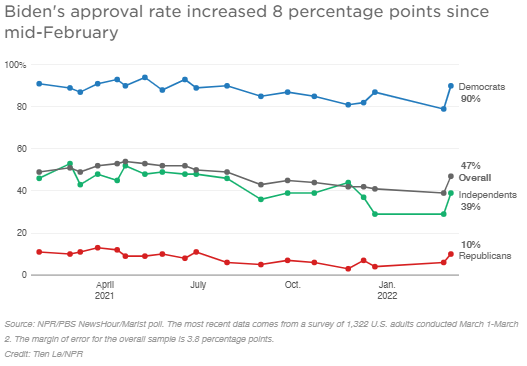
The Big Sort, Cont’d: “Of the nation’s total 3,143 counties, the number of super landslide counties — where a presidential candidate won at least 80% of the vote — has jumped from 6% in 2004 to 22% in 2020,” according to Larry Sabato’s latest data reported on NPR. But we already kinda knew this. Remember what Dave Wasserman of Cook Political Report pointed out back in December 2020:
In fact, Wasserman’s data got even more interesting when he excluded counties that have both: Biden won 95 percent of counties with only a Whole Foods and just 18 percent of counties with only a Cracker Barrel.
Biden’s Got Jokes: A great lesson for would-be staffers and operatives from Kristen Soltis Anderson in her latest newsletter. During his State of the Union, President Biden made a joke about the “infrastructure decade.” And if you didn’t get the joke, that’s kind of my point. So how did an inside joke that would be funny only to Hill staffers and the most online politicos end up in SOTU and what does it say about how in touch the Biden admin is with the world outside their bubble? Either they knew only their friends would get it and were okay with that. Or they thought more people would understand the joke, which is another problem altogether. As David Shor has pointed out repeatedly, “the people who run and staff the Democratic Party are much more educated and ideologically liberal and they live in cities.” That manifests as a campaign problem with candidates and messaging. But it’s also a campaign problem when your boss is at 37 percent and you’re writing a speech for the largest audience he will have had in more than a year.
The Chicken and the Egg: Part 1
In the first few editions of this newsletter, I tried to explain the different roles within a campaign—opposition research, data and digital, communications, finance, legal, field and political, polling, candidates, etc. But I haven’t spent any time on the different types of campaigns. So this is the first in my two-part series on how to change the world.
I’m excited to read Daniel Laurison’s new book, Producing Politics: Inside the Exclusive Campaign World Where the Privileged Few Shape Politics for All of Us, in which he argues that “campaigns are riddled with outdated strategies, unquestioned conventional wisdom, and preconceived notions about voters that are more reflective of campaign professionals implicit bias than the real lives and motivations of Americans.” Yep, yep, and yep.
But a lot of the data he is looking at is from my world—presidential politics. And while it’s true that folks like me also work in the offseason—on Senate races or other statewides usually—we are still a very specific subset of campaign operatives. As Laurison points out, we are not only more educated than American voters as a whole (remember the single largest voting bloc is white, non-college educated voters), we are more likely to have gone to elite schools, as you can see in the chart below.

But that is presidential politics. And while all presidential campaign operatives may have worked on a state race, not all—or even most—state-based operatives will have worked on a presidential race. And so now I shall introduce a metaphor that may only work for people who love both politics and African cats.
If presidential campaign operatives are cheetahs—highly specialized carnivores—then state-based operatives are lions—also highly specialized carnivores that overlap in both territory and prey with cheetahs. But then there are local campaign operatives. It actually isn’t very common to meet someone on a governor’s race or a presidential race who has ever worked a race for mayor or city council. These are the servals—still highly skilled (some might argue more skilled?) and still covering the same territory as our big cats but almost no overlap in prey since servals go for rodents, insects, and the like.
But we’ve still left out another species of operative that I’m going to refer to as ballot measure operatives. Their work is on the same ballot, but it looks totally different. They are the African clawless otters. They too hunt. But in a totally different place and in a completely different way. Plus they’re considered adorable and lovable and nobody hunts them for sport.

And so this brings me to a news article I saw a couple weeks ago: “Why cage-free eggs becoming norm.” In 2010, 4 percent of hens were roaming free. In 2020, that number was 28 percent. And in four years, it’s going to be closer to 70 percent. This isn’t an accident. These are otters!
Beginning in about 2015, McDonald’s, Burger King and other national restaurant chains as well as dozens of grocers and food manufacturers responded to pressure from animal welfare groups by announcing their commitment to cage-free eggs. That was followed by laws requiring cage-free housing in California and similar rules in at least seven other states — Colorado, Massachusetts, Michigan, Nevada, Oregon, Utah and Washington.
It reminded me a lot of Mothers Against Drunk Driving—widely held up as one of the most successful political movements in the country from the last half-century. According to the Department of Justice, “between 1982 and 1997, more than 1,700 pieces of anti-drunk driving legislation were passed nationwide.” But MADD was successful not just—or even primarily—because it was able to get the National Minimum Drinking Age Act signed into law and reduced the legal limit to .08 percent blood alcohol content in all 50 states.
They changed the culture around drunk driving.
When I was growing up, it was cool to brag about how buzzed you were driving home. Being killed by a drunk driver was tragic, but it was an accident. In the early 1980s, 28,000 people were dying in alcohol related car crashes every year and 57 percent of all traffic fatalities were alcohol related. As of 2019, alcohol accounts for only 28 percent of fatalities. And the number of people killed—despite a lot more people driving and a lot more miles driven per American compared to 40 years ago—was 10,142.
Law alone doesn’t change a culture like that. Brown v. Board of Education didn’t integrate schools—a full decade later more than 98 percent of black children still attended an all-black school. Busing in Boston required 400 court orders, caused violence, and white enrollment plummeted in affected schools. My point being that those MADD otters did something remarkable.
So after reading the story, I tweeted something comparing the cage free movement to MADD. And a few hours later, I got an email from the head otter at the Humane Society, which led this effort!
Josh Balk has an incredible resume: He’s gotten legislation passed criminalizing factory farming abuse in more than a half-dozen states; he’s worked with Walmart, General Mills, McDonald’s, Kroger, and Perdue; he’s the founder of JUST, which is almost certainly being sold at your local grocery store; and he’s got a case currently pending at the Supreme Court that we’ve talked about on Advisory Opinions.
Josh very graciously gave me an hour of his time to try to explain to a cheetah what it’s like to be an otter and how he has become the most successful otter in America. Next week, we’re going to get into the weeds of how he did it. But let’s back up for a moment and reflect on how hard this is.
Foie gras bans have largely failed or been repealed—even though very few Americans will ever try it in their entire lives. Fewer than a third of Americans own a gun, 94 percent think gun violence is a problem, and the vast majority of Republicans and Democrats want universal background checks—and yet the majority of states haven’t passed anything. Ballot measures on school choice, criminal justice, and any number of other issues I would argue haven’t moved the needle in a larger cultural sense despite their popularity and the relatively low impact it would have on voters’ lives.
Nearly every American eats eggs—and chickens for that matter. And this will make eggs more expensive.
So how was Josh able to build that momentum without partnering with a political party, or getting trapped into a culture war narrative, or alienating liberal allies by working with conservative allies, or facing backlash by working with large corporate interests, or stymied by the industries that didn’t want to spend billions of dollars refitting all of their chicken warehouses?
How does an otter avoid every crocodile, fish eagle, and python while still eating its fill? We’ll find out next week.
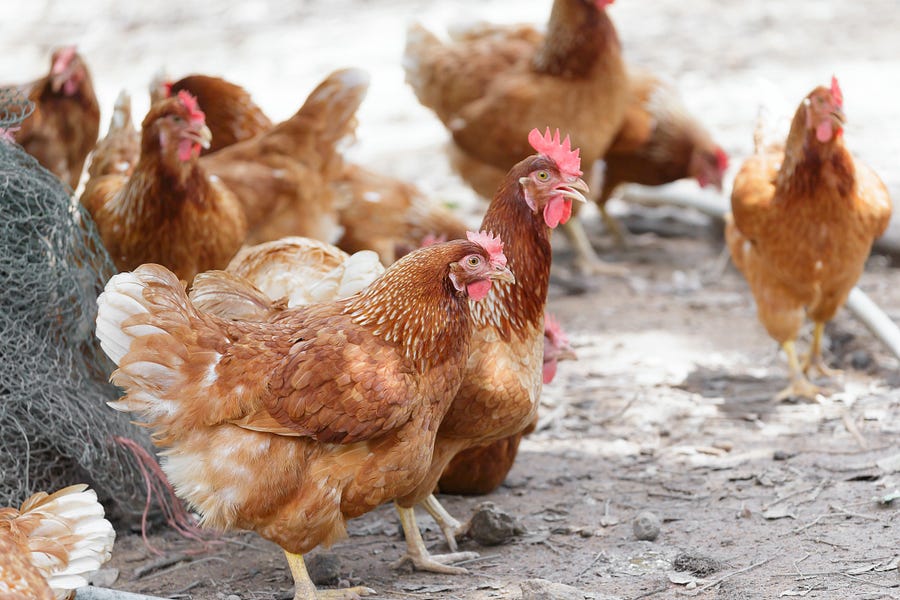


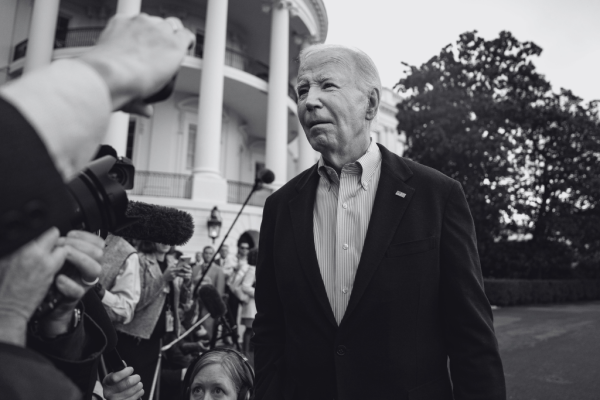

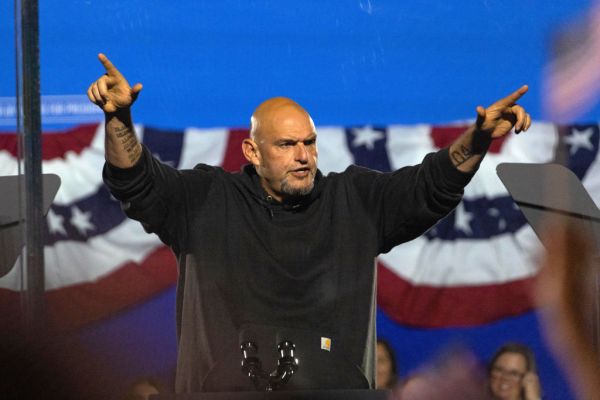

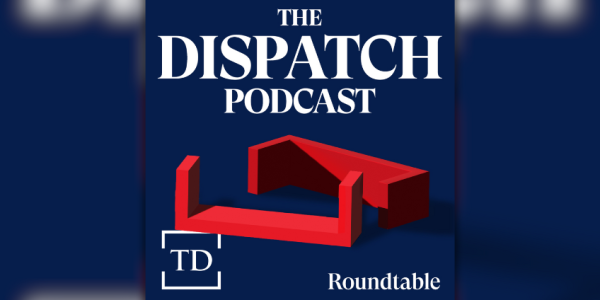

Please note that we at The Dispatch hold ourselves, our work, and our commenters to a higher standard than other places on the internet. We welcome comments that foster genuine debate or discussion—including comments critical of us or our work—but responses that include ad hominem attacks on fellow Dispatch members or are intended to stoke fear and anger may be moderated.
You are currently using a limited time guest pass and do not have access to commenting. Consider subscribing to join the conversation.
With your membership, you only have the ability to comment on The Morning Dispatch articles. Consider upgrading to join the conversation everywhere.